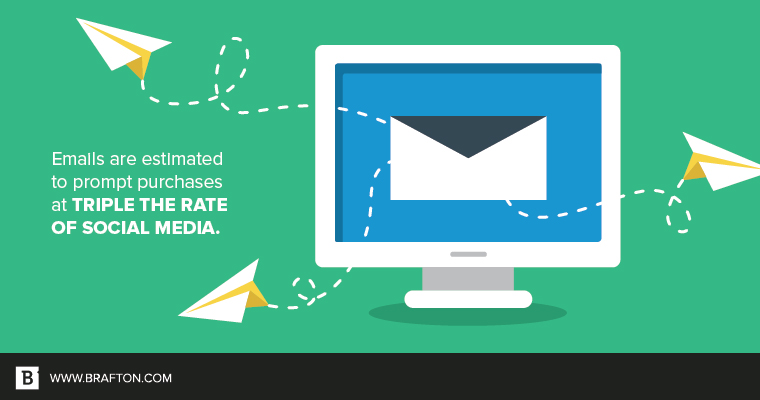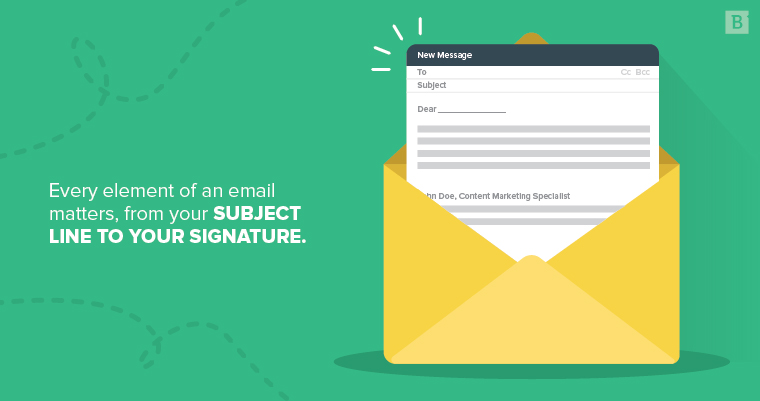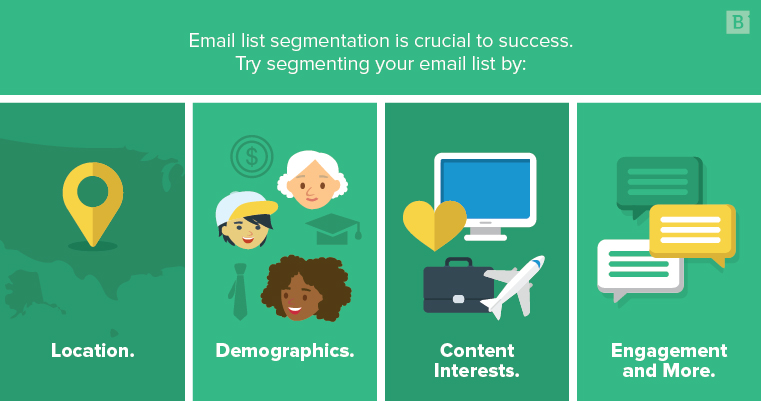Updated 2/6/18
A strong B2B email campaign is strategic, comprehensive and a must-have for success in the digital market.
Doubtful? Well, you’re going against the grain. Email is the most popular content distribution choice among B2B marketers. It drives the most leads, brings in the most revenue and shows the highest return on investment of any other channel.
Clearly, email is on to something.

Actually, it’s been on to something. Email is one of the oldest forms of online marketing. And considering the sheer number of email accounts out there – approximately 3.7 billion – it’s not likely to go away soon.
The key to longevity for brands, however, is to adapt to shifting client expectations and available technology. Email marketing has gotten more sophisticated over the past few decades. Some people may interpret that statement as “more confusing,” but we’re here to make it simple. Follow along as we break down the major themes of email marketing:
Understanding different types of email campaigns
Variety is the name of the game when it comes to B2B emails. You want to use multiple styles so your messages remain relevant and your audience stays engaged.
Here are five types of emails you’ll use often as a B2B marketer:
- Prospecting emails: These are similar to outbound calls, only they’re sent through inboxes instead of phones. A good prospecting email is targeted and personalized, rather than a message sent out en masse. But most importantly, it’s relevant to the prospect – referring to a recent success, relating to a stated mission, acknowledging common goals. Relevance plus personalization leads to trust, which then fuels a relationship, which then turns into a sale.
- Promotional emails: You probably receive a bunch of these per day, and chances are, they’ve worked (at least, they do on me. Sephora gets me all the time with these.) Promotional emails promote a specific product or service, typically with a discount or trial offer. They can be particularly effective for luring consumers who are on the fence about your product. A discount or free trial might be just what that person needs to convert.
- Newsletters: In another post, we said that email newsletters will look increasingly like brand magazines this year. As with any form of content, you want your newsletters to be targeted and chock-full of usable information or fascinating insights. You may find it helpful to base your newsletter strategy around a real magazine – something like “O,” “Vogue” or “The Economist.” Each of these speaks directly on topics that their publishers know interest their target audience.
- Lead nurturing emails: Also known as trigger campaigns, lead nurturing emails are generated from a specific action on the reader’s end. We’ll talk about this more later, but a great way to build your lead nurturing email list is through gated content. This means users have to exchange some information – names and email addresses at the bare minimum – to access the content.
- Drip campaigns: These are automated email campaigns that I personally think are the coolest of the bunch. That’s because the content sent out is all based on the recipient’s action or lack thereof. For example, a reader could receive an email containing a link to a white paper. Whether or not she clicks that call to action dictates what email she’ll receive next, and so on and so forth.
Each type of campaign should complement and work with the others in a coordinated action, so it’s to your benefit to mix and match them within your strategy. This way, you can capture as many leads as possible while having enough variety to keep people’s interest.

How to create an email database
A B2B email marketing strategy is nothing if you don’t have addresses to send it to.
Building a database of opt-in email addresses is the best way to go about developing your audience. Then, you can segment and optimize that list for better results.
Boost your email list by creating:
- Gated assets: I brought this up earlier, and it’s time for more detail. Gated content gives readers a reason to give you their contact information. They fill out a form, then receive a downloadable asset full of valuable information in exchange. Best practice is to include a disclaimer on the form specifying that, by submitting their information and downloading the asset, the reader agrees to receive additional content via email.
- Email newsletters: We’ve got one, and we’re consistently impressed with the results. Ideally, a newsletter supplements your blog posts, news alerts and other content. At the same time, it makes life easier and better for the reader, either by showcasing exclusive content or rounding up your best hits so the reader doesn’t have to. And trust us: You’ll see the best success by using pop-up forms to attract subscribers. Here are some stellar email newsletter examples to check out for inspiration.
- Shareable email campaigns: Your existing contacts are a great source of new leads. Create email campaigns with calls to action encouraging readers to share with their friends, colleagues and clients on social media. If these additional contacts like what they see, they’ll subscribe for future content from you.
- Free tools: If you provide a web-based service, creating free tools is a great way to build an interested audience. Think of CoSchedule’s Headline Analyzer – a service I’m particularly fond of. I don’t have to pay to use it; all I did was give CoSchedule my email address and I can analyze the titles of any content I write. In exchange, I get added to one of their marketing lists, which means I also receive helpful tips on creating better content. Two benefits all for a simple address!
You’re not done once you’ve created your list, however. You have to continuously update with fresh leads and new addresses. Your database will degrade by almost 23 percent every year as contacts abandon old addresses, switch companies or opt out of email communications. Keep your list full and up to date so your messaging reaches its intended targets.
Also, it’s not advisable to buy or rent an email list without discussing with your email marketing software vendor. Some are pretty picky about these, so either choose one that’s a little less strict or avoid them. The latter option might make prospecting hard, however, so make your choice wisely!

Segmenting your list
Remember: Content marketing is all about effectively collecting and using data. How does this apply to B2B email? Well, not everyone on your list will be interested in all the content you provide, and flooding a prospect with emails they don’t want is a surefire way to lose their engagement. You’re much better off using data to segment your audience into different categories and sending targeted emails to each group. And the payoff is great. When MailChimp compared users who segmented their emails versus those who did not, they found that the former saw:
- 9.4 percent fewer canceled subscriptions.
- 3.9 percent fewer abuse reports.
- 14.3 percent higher open rate.
- 10.6 percent higher unique open rate.
- 101 percent higher clickthrough rate
A lot of work, but clearly worth it. You can segment your email list by:
- Location: The needs of an Iowan customer are likely different than those of one living in LA, so structure your emails accordingly. Also, pay attention to time zones when sending emails.
- Demographics: Most people think of demographics in terms of age and gender, which are both more suited for B2C targeting. However, B2B businesses can demographically segment their email lists by company position, industry or similar categories. A chief financial officer is probably interested in different information than an accountant, after all.
- Content interests: If your gated assets span a variety of topics, segment your list in terms of who downloads what.
- Engagement: Who opens all of your emails? Who reads and comments on each of your blog posts or LinkedIn articles? People who are more engaged with your business likely want longer or more detailed emails than those who aren’t.
- Purchases: Customers who bought the same product generally have similar needs, so it stands to reason they’ll be interested in the same email content. You can also use this same list to upsell like customers on related products.
These are just a few examples, and the data you have may tell you to segment your database differently.

Tips for creating a strong B2B email campaign
Alright, now that you know what you’re sending and who you’re sending it to, it’s time to get down to the nitty gritty. How do you write an email that is opened, read and leads to conversions?
Every element of the email matters, from your subject line to your signature.
Start with a compelling subject
A great subject is creative, informative and interesting, but doesn’t give anything away. It intrigues readers by offering a sense of what’s to come, grabbing their interest and not letting go.
That said, it should also be brief. Most email clients can only display up to 50 characters; anything extra gets cut off. If you must write a lengthy subject line, make sure your readers get the details they need up front.
Your subject line is a call to action all on its own, and the only action is to click it open. To spur readers into doing so, focus on:
- Urgency: Make your audience feel like they’re missing out if they don’t read your email immediately.
- Relevance: Your audience needs to know the content inside is worth their while.
- Pain points: Everyone’s looking for a better solution, after all.
- Numbers: Including numbers in a subject is a quick, short way to provide context on whatever you’re talking about.
Choose a proper sender and address
A lot of mass emails are sent from noreply@companyname.com. It’s an efficient address, but not one that’s good for building trust or humanizing your business. Just imagine if this blog were written by No Reply.
Choose a real person from your company to be the sender. Many companies select one or more members of their marketing teams. If you wanna get crafty, have different senders for each of your list segments to build familiarity with each audience.
Writing content
Like headlines, your content should be concise. People are busy, and they want to get to the point as fast as possible.
That said, just because your content is on the brief side doesn’t mean it has to be boring. Break up chunks of text with interesting visuals: CTAs, captions, images, colorful headlines, etc. Just don’t go overboard; use plenty of white space so your email isn’t overwhelming.
Also, make sure the colors you use are close to your core visual branding. Everything about your email should scream your company name.
Furthermore, keep in mind that many people read emails on phones, tablets and smartwatches. Make sure your messages are designed to display well on these devices.
Finally, optimize any landing pages linked in your email so you don’t lose conversions at the last second. Slow loading times and poor navigation can all cost you a crucial sale just when you thought you had things in the bag.

Making B2B email work for you
A strategic, effective B2B email campaign is more than purchasing a list of contacts and sending them a newsletter every once in a while. You want to create a thorough strategy that’s just as important as your traditional content. In fact, email is your best tool for distributing that content to the people you know are interested in your business.
That said, an effective strategy is also cumulative. Just as a great content archive contains articles, white papers, eBooks and infographics, a good email strategy uses different types of emails and segments messages based on specific markets
Keep in mind, your email campaign isn’t something you build once and forget about. You need to constantly revisit your email database, segments and messaging to make sure they stay optimized.
Got all that? We wanna hear what you think about it! What email marketing tips do you have to share, and what do you want to incorporate this year?





